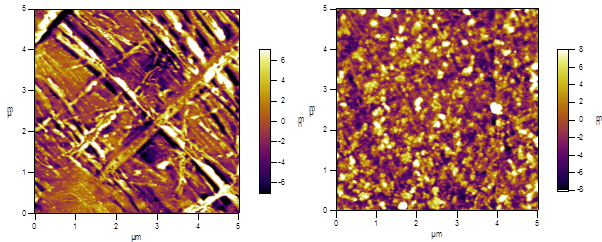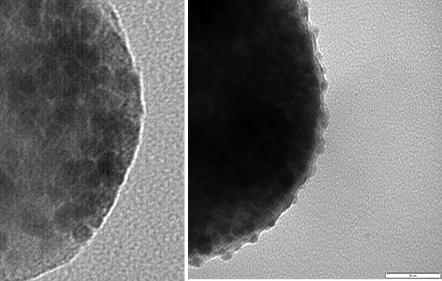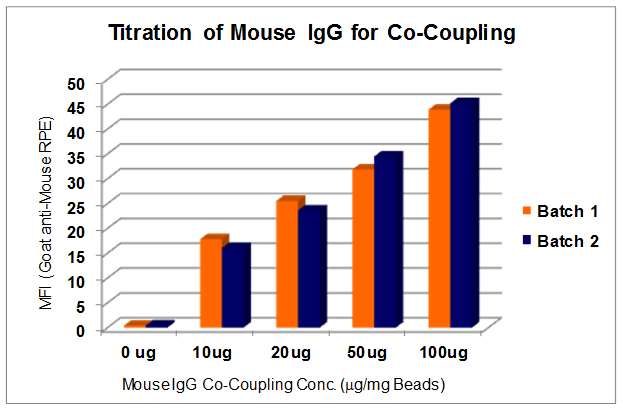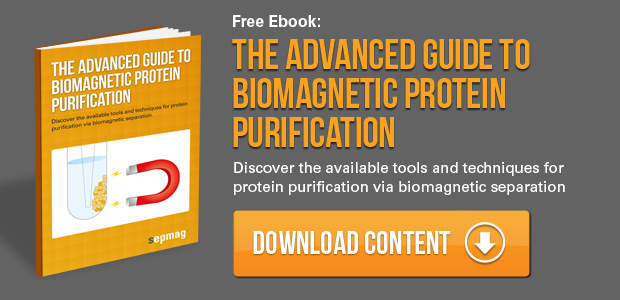Nanoparticles incorporating different functions are useful and necessary products for assays, drug delivery, and other life science applications. For example, magnetic nanoparticles can be used as contrast agents for magnetic resonance imaging (MRI), to dissipate energy under an oscillating field to locally raise temperature (hyperthermia), or to improve manufacturing of complex nanoparticles via use of magnetic separation. One or more different antibodies and/or fluorescence, luminescence agents as well as other functionalities such as catalytic or enzymatic groups can be attached to nanoparticles.
However, achieving reproducible and controllable addition of just one protein (let alone two or more different proteins) into ever smaller particles is a major challenge - and a technically complicated process. When additional requirements, such as the need to prevent aggregation and to maintain size uniformity are added, simple procedures that are compatible with many different particles are difficult to find. You can always learn why in our protein purification handbook.
Forming Nanometre Glues
Metal polymers - as Mix&GoTM - are able to coat a broad variety of particles including nanoparticles such as bare magnetite (15 nm) and QDots (10 nm). Coating a particle with those polymers effectively addresses the issue of aggregation as charge repulsion prevents clumping of the activated particles. As well, charge attraction in combination with multiple coordination forces give rapid and efficient binding of synthetic or bio-polymers such as proteins to the coated particles.
There are a number of benefits in using metal polymers but for forming multi-functional nanoparticles, two important characteristics are discussed:
1. Formation of a thin coating. Depending on the surface and the type of metal (cationic) polymer, a “glue” layer as thin as one metal ion in thickness (approx. 0.2 nm) can be formed. On rigid surfaces like injection moulded COC plastics, a product like Mix&Go forms <1 nm films that maintain the pre-existing contours of the underlying material. The surface roughness of injection moulded COC does not change after activation (see Fig. 1). On “softer” surfaces such as 200 nm magnetic particles, it forms films of 2 to 3 nm in thickness (established using Zeta-sizer and TEM). In Fig. 2, 10 nm QDots coated onto these 200 nm magnetic particles are clearly seen as approx. 7 nm dimples on the 200 nm particle surface.

Fig. 1. Injection moulded COC (left) has a surface roughness calculated at 4.7 nm ± 0.5 nm by Atomic Force Microscopy (AFM). After addition of aqueous Mix&Go solution and wash, these activated COC surfaces (right) give essentially the same surface roughness at 4.5 nm ± 1.0 nm.

Fig. 2. Transmission electron microscopy (TEM) of untreated 200 nm magnetic particles (left) and QDot coupled Mix&Go activated 200 nm magnetic particles (right). QDots are seen as 6 to 8 nm dimples from the background contour of the 200 nm particle.
2. Rapid kinetics. On protein binding, using the polymer activated surfaces give high reproducibility of protein density as well as tight particle-to-particle uniformity. Their rapid kinetics means that the amount of protein added correlates highly (R2 of 0.99) with the amount actually coupled to the particle. As an example, a mixture of two proteins (streptavidin and mouse mAb) was coupled onto 200 nm magnetic particles. As shown in Fig. 3, antibody titration clearly demonstrates a linear correlation between antibody added and antibody actually loaded onto the particles as determined by anti-mouse detection.
Similarly, streptavidin loading can easily be manipulated allowing two or more distinctly different proteins to be incorporated onto 200 nm magnetic nanoparticles in controllable ratios. In contrast, using passive or amide chemistry it is very difficult to obtain reproducible and consistent ratios of proteins. This difficulty increases with decreasing size of the nanoparticle. Similarly, even more complicated mixtures of different proteins can be assembled on metal (cationic) polymers activated particles in a controllable and predictable manner.

Fig. 3. Titration of mouse IgG that was co-coupled with streptavidin on Mix&Go activated magnetic nanoparticles (Merck, 200 nm). Because there is a linear correlation between what is added for binding and what actually binds, it is possible to reproducibly bind two or more proteins in a controlled manner.
Conclusion
Aqueous metal polymers, like the used in Mix&Go, can bind a wide array of different surfaces in as little as a few minutes. Due to its ability to form thin coatings and to its rapid kinetics, these nanometre “glues” can bind proteins and/or other polymers and nanoparticles to create multi-functional and /or multi-layered constructs in a relatively simple and reproducible manner. The technology enables construction of antibody and enzyme conjugates via nanoparticles and similar constructs. It does so while minimising the tendency of nanoparticles to aggregate.
You will find this post and many more interesting articles about using biomagnetic separation for protein purification in our Advanced Guide to Biomagnetic Protein Purification:
Related articles:
- Key benefits of Magnetic Sepharose beads
- Novel Hyper-porous Polymer Magnetic Beads as High-capacity/Fast separation alternative
- Effect of Particle Size Distribution of Magnetic Particles in Protein Purification Processes
Author: Joe Maeji, Ph.D., CSO Anteo Diagnostics, Brisbane, Australia
Joe’s area of interests has been on the commercialisation of products and technologies at the interface of chemistry and biology for over 20 years.
Joe was a co-founder of the company that became Anteo Diagnostics as well as its founding CEO. Previously, he held senior management positions at Mimotopes Pty Ltd, Melbourne, Australia and at Chiron Corporation, San Francisco, USA. He holds a BSc in chemistry from University of Queensland, Australia, MPhil in enzymology from Griffith University, Australia and PhD in Polymer Engineering from the Tokyo Institute of Technology, Japan.




